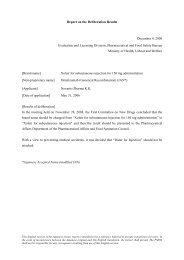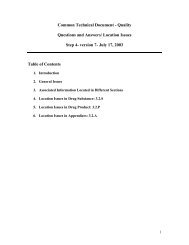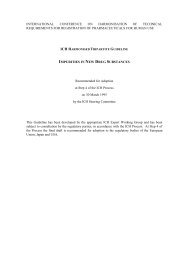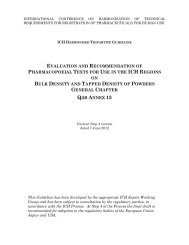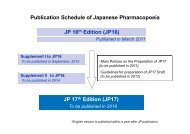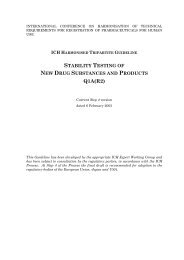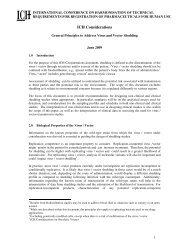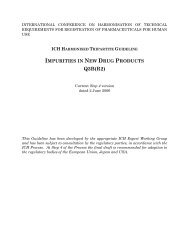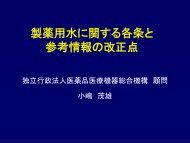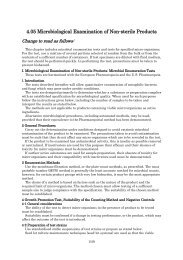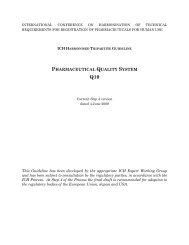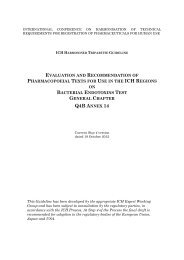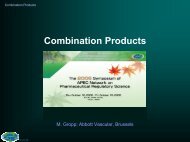POST-MARKETING SAFETY MEASURES IN JAPAN
POST-MARKETING SAFETY MEASURES IN JAPAN
POST-MARKETING SAFETY MEASURES IN JAPAN
You also want an ePaper? Increase the reach of your titles
YUMPU automatically turns print PDFs into web optimized ePapers that Google loves.
<strong>POST</strong>-<strong>MARKET<strong>IN</strong>G</strong> <strong>SAFETY</strong><br />
<strong>MEASURES</strong> <strong>IN</strong> <strong>JAPAN</strong><br />
East Asian Pharmaceutical Regulatory<br />
Symposium 2008,Tokyo(東京)<br />
2008,Tokyo(東京)<br />
Mr. Akira Kawahara<br />
Chief Safety Officer, Officer PMDA,<strong>JAPAN</strong><br />
April, 2008
Overview of PMDA<br />
NAME: Pharmaceuticals and Medical Devices Agency<br />
<strong>IN</strong>AUGURATION : April 2004<br />
MANAGEMENT: ・Effective operation under “Medium Term Plan”<br />
for 5 years’ activities<br />
・Subject to regular evaluation of performance by<br />
the Evaluation Committee organized by MHLW<br />
F<strong>IN</strong>ANCE: Corporate accounting method and subdivided accounts<br />
according to the functions<br />
Financial resources:<br />
• User fee (Review and Inspection)<br />
• Contribution Funds (Post-marketing, Relief)<br />
• Appropriation from Gov. budget<br />
2
Adverse Health Effect<br />
Relief Services<br />
Organization of PMDA<br />
PMDA’s Services<br />
Post-marketing Safety<br />
Operations<br />
Reviews and Related<br />
Operations<br />
3
3 Pillars of Safety Operations<br />
Post-marketing Safety<br />
Operations for Drugs/<br />
Medical Devices<br />
Reinforced Safety Information (Database)<br />
Scientific Review and Research for Safety<br />
Information<br />
Information Provision (via the Internet),<br />
Pharmaceutical Consultation for Consumers<br />
4
Post-Marketing Safety Scheme<br />
PFSB 143 staff --- Safety Div. 27 staff<br />
PMDA 348 Staff --- Office of Safety 38 staff<br />
Safety<br />
Information<br />
Dissemination<br />
Medical Institutes, etc.<br />
MHLW<br />
PMDA<br />
Safety Data Collection<br />
Safety Information Dissemination<br />
Review/<br />
Recommendation<br />
Reporting of Reporting of<br />
ADRs/Infectious ADRs/Infectious<br />
Diseases<br />
(3,609cases, FY2006)<br />
Diseases<br />
(26,309cases, FY2006)<br />
MAH<br />
PFSC*<br />
- Review line-list of ADRs/Infectious diseases<br />
- Make recommendations on safety measures,<br />
such as revision of package insert<br />
Instruction of Safety<br />
Measures<br />
* Pharmaceutical and Food Safety Council<br />
5
Organization of Ministry of Health,Labour and Welfare<br />
Ministry of Health, Labour and Welfare<br />
Ministry Proper<br />
Minister’s Secretariat<br />
Health Policy Bureau<br />
Health Service Bureau<br />
Pharmaceutical and Food Safety Bureau (PFSB)<br />
143 staff<br />
Social Welfare and War Victim’s Relief Bureau<br />
Health and Welfare Bureau for the Elderly<br />
Equal Employment, Children, and Families Bureau<br />
Insurance Bureau<br />
Pension Bureau<br />
Director-General for Policy Planning and Evaluation<br />
Social Insurance Agency<br />
General Affairs Division<br />
Evaluation and Licensing<br />
Division<br />
Safety Division 27 staff<br />
Compliance and Narcotics<br />
Division<br />
Blood and Blood Products<br />
Division<br />
6
FY2008 Budget for Pharmaceuticals<br />
(Pharmaceutical and Food Safety Bureau, MHLW)<br />
• FY2008 Budget ¥8,882mil./$88.9mil.<br />
(Safety Div. ¥249.6mil./$2.5mil)<br />
• FY2007 Budget ¥8,916mil./$83.5mil.<br />
(Safety Div. ¥243.4mil./$2.4mil)<br />
– Difference △¥34mil./$0.32mil.<br />
– FY2008/FY2007 99.6%<br />
NOTE: Japanese FY covers the period of Apr. 1 through Mar. 31.<br />
$1=¥99.95 (as of Mar.19, 2008)<br />
7
Chief Safety<br />
Officer<br />
PMDA: Office of Safety --Organization chart--<br />
Office of<br />
Safety<br />
(38 regular<br />
staff)<br />
In addition, There are around 30<br />
support staff and clerks as well as<br />
5 part-time professional advisors<br />
(MD and statistician).<br />
Planning & Management Div. (4 staff)<br />
Safety Info. Div. (4 Staff)<br />
Info. Support Group<br />
Surveillance and Analysis Div.(6 Staff)<br />
Drug Safety Div. (16 Staff)<br />
Medical Device Safety Div.(7 Staff)<br />
Medical Safety Info. Group<br />
8
FY2008 Budget for Pharmaceuticals<br />
(Office of Safety, PMDA)<br />
• FY2008 income from MAHs est. ¥ 1,280 Mil.<br />
• FY2008 MHLW subsidy est. ¥ 252 Mil.<br />
• Others est. ¥ 4 Mil.<br />
• (total ¥ 1,536 Mil.)<br />
• FY2007 income from MAHs ¥ 1263 Mil.<br />
• FY2007 MHLW subsidy ¥ 255 Mil.<br />
• Others ¥ 5 Mil.<br />
• (total ¥ 1,523 Mil.)<br />
• Covering budget for Medical Devices Safety and partially<br />
for Quality (GMP/QMS and standard development)<br />
9
About20<br />
Healthy<br />
Subjects<br />
PhaseI<br />
For “Safer” Drugs / Devices<br />
= Unknown Risk<br />
= Known Risk<br />
About 50<br />
Limited<br />
Number of<br />
Patients<br />
Large<br />
Number of<br />
Patients<br />
II III<br />
Review<br />
More than<br />
100<br />
Review and Approval<br />
ADR and Infectious Disease Report System<br />
Various cases undetected<br />
even by doctors<br />
Early-phase Postmarketing<br />
Vigilance<br />
Reinforce Risk Management<br />
Inseparable Pair<br />
Post-marketing<br />
Surveillance<br />
Safety<br />
Reexamination<br />
and<br />
Reevaluation<br />
10
Academic Journals,<br />
etc.<br />
Collect and study<br />
Information on Quality,<br />
Efficacy and Safety of<br />
Drug/Medical Device<br />
Analysis<br />
Consideration of<br />
Safety Measures<br />
Vigilance Operation Flowchart<br />
Safety Information<br />
Collection<br />
Foreign Government<br />
Agencies, WHO<br />
Company PMDA<br />
MHLW<br />
Report<br />
Interviews<br />
Medical<br />
Medical<br />
Institutes,<br />
Institutes,<br />
Clinics,<br />
Clinics,<br />
Pharmacies,<br />
Pharmacies,<br />
etc.<br />
etc.<br />
(ADRs)<br />
(ADRs)<br />
Receipt of Information on<br />
Quality, Efficacy and Safety<br />
of Drug/Medical Device<br />
Company Interviews<br />
Data Collection, Analysis,<br />
Evaluation<br />
Healthcare Providers, Mass Media,<br />
the Public<br />
Real-time<br />
Notification Grasp All Information<br />
Report<br />
Extract Urgent &<br />
Significant Information<br />
Administrative<br />
Considerations, Policy<br />
Planning for Safety<br />
Measures<br />
Instruction and<br />
discussion of<br />
Consultation with Experts<br />
Safety<br />
Measures<br />
Data Arrangement, Study<br />
Results<br />
Implementation of<br />
Safety Actions<br />
Instruction of Labeling<br />
Change, Quality<br />
improvement, Recall, etc. Information Distribution<br />
PFSC<br />
Implementation of<br />
Safety Actions<br />
Information Distribution<br />
Safety Information<br />
Collection<br />
Information Distribution<br />
11
Information Source<br />
-Healthcare providers<br />
-Scientific journals or<br />
meetings<br />
-Foreign Govs. etc.<br />
Outline of Information Flow (1)<br />
(MAH)<br />
Collection of Safety<br />
Information<br />
Marketing<br />
Supervisor<br />
General<br />
Report<br />
Direction,<br />
Decision<br />
PMS Manager<br />
Execution of Safety Measures<br />
Report to PMDA<br />
Coordination<br />
- Collection and analysis of safety info.<br />
- Planning and execution of safety measures<br />
PMS Management Dept.<br />
MAH<br />
Quality Assurance<br />
Manager<br />
- Healthcare providers<br />
- Hospitals, pharmacies etc.<br />
-PMDA<br />
12
PMDA<br />
Outline of Information Flow (2)<br />
Report from<br />
Company<br />
Interview with company<br />
+<br />
Data collection, analysis,<br />
evaluation<br />
RA: Regulatory Authority<br />
Report<br />
- Information from RA, WHO<br />
- Academic Journals<br />
- Report from HCPs<br />
MHLW<br />
- Grasp all information<br />
- Extract significant info.<br />
- Planning for safety<br />
measure<br />
PAFSC<br />
Safety Actions<br />
(Administrative Advice for revision of package insert etc.)<br />
13
PMS<br />
Risk Minimisataion<br />
Risk Communication<br />
JP Postmarketing activities<br />
Safety report<br />
Re-examination<br />
Periodic Safety Report<br />
Incl. PSUR<br />
Periodic<br />
Re-evaluation Ad hoc<br />
EPPV<br />
Expedited<br />
Periodic<br />
Drug Use Investigation<br />
Drug Use Investigation<br />
of Special Population<br />
Postmarketing Clinical Trial<br />
Quality<br />
14
Pharmaceutical<br />
Company<br />
ADR Reporting by MAH<br />
Electronic<br />
Reporting<br />
FD<br />
Paper<br />
Documents<br />
�Electronic reporting transmitted by internet<br />
�Reporting by FD<br />
�Reporting by paper documents<br />
ICSR<br />
Data input<br />
PMDA<br />
DataBase<br />
15
ADR Report from HCP<br />
• voluntary basis<br />
– since 1967: designated medical institutions<br />
– since 1984: designated pharmacies<br />
– since 1997: all medical institutions and pharmacies<br />
• stipulated in PAL<br />
– since 2003<br />
• HCPs shall report to MHLW when<br />
– detect occurrence of any disease suspected to be caused<br />
by adverse reactions<br />
– confirm that it is necessary to prevent occurrence or<br />
spread of hazards<br />
16
Medical Institutes<br />
④<br />
Investigation<br />
Pharm. Company<br />
ADR Reporting by Med. Inst.<br />
⑤<br />
Electronic<br />
Reporting<br />
FAX<br />
① ②<br />
Postal<br />
Mail<br />
ADR Reporting by Company<br />
③<br />
Feedback<br />
MHLW<br />
(Paper and<br />
Electronic<br />
Reports)<br />
PMDA<br />
17
Seriousness<br />
Serious<br />
Not<br />
serious<br />
ADR Reporting Rule (Drug)<br />
predictability Time frame of report to<br />
PMDA<br />
Not<br />
predictable<br />
15 days<br />
Predictable - Death etc.* 15 days<br />
Not<br />
predictable<br />
- Others 30 days<br />
Annually<br />
(Annual Cumulative Report)<br />
Predictable -<br />
* - Death<br />
- ADR caused by new drug ingredient within 2 years after approval<br />
- ADR detected by Early Phase Post-marketing Vigilance (EPPV)<br />
• Reporting time frame<br />
depends on seriousness and<br />
predictability of the case.<br />
(Article 253 of the Ministerial<br />
Ordinance on PAL)<br />
• No timeframe defined for<br />
HCP reporting<br />
18
Reported ADR/ ADR Infectious Disease Cases<br />
120000<br />
100000<br />
80000<br />
60000<br />
40000<br />
20000<br />
0<br />
Medical Professionals<br />
Companies(Foreign Report)<br />
Companies(Domestic Report)<br />
1996 1997 1998 1999 2000 2001 2002 2003 2004 2005 2006<br />
19<br />
Note :Foreign reports by drug makers are not included in and before FY03’.
Course of Post-marketing Safety<br />
Measures<br />
• After-the-Fact Measures (Measures taken after the incidence<br />
of ADR)<br />
• Prognostic Measures (Measures taken for drugs/patients with<br />
possible incidence of ADR)<br />
• Preventive Measures (Measures taken for high-risk situation<br />
(high-risk patients etc.))<br />
20
Safety Measures<br />
• Revision of a package insert<br />
• Recall/withdrawal, suspension of the sale<br />
• Improvement of the products to prevent reoccurrence of<br />
the AE<br />
• Administrative Instruction/Advice by PMDA/MHLW to<br />
MAH to revise safety information in package insert;<br />
“Precautions for Use,” “Boxed Warning,” etc.<br />
• Dissemination of information on ADR/AE incidents and<br />
measures against them (e.g., publication of<br />
“Pharmaceuticals and Medical Devices Safety<br />
Information” and “Urgent Safety Information” by MHLW)<br />
etc.<br />
21
Early Phase Post-marketing Vigilance<br />
(EPPV)<br />
• Promote proper use of new drugs<br />
• Detect serious ADRs earlier<br />
• Take safety measures quickly<br />
• Protect patients from ADRs<br />
22
Early Post-Marketing Phase Vigilance : EPPV<br />
Enforced on Oct 1, 2001<br />
1. To ensure necessary information for<br />
appropriate use (contraindication, careful<br />
administration etc ) is explained to the<br />
medical institutions 2 weeks before delivery.<br />
2. To request medical institutions to use the<br />
drugs carefully and report serious ADRs, if<br />
occurred, immediately to pharmaceutical<br />
companies<br />
3. To request appropriate use and ADR<br />
reporting repeatedly to medical institutions for<br />
6 months after delivery.<br />
23
Early Phase Post-marketing Vigilance, EPPV<br />
Sale<br />
Preparation of<br />
the protocol of<br />
EPPV<br />
explanation<br />
0<br />
Delivery of new drugs<br />
to medical institutions<br />
every 2 wks<br />
2months<br />
once a month<br />
6months<br />
giving information by visiting,<br />
letters, FAX, E-mail etc.<br />
Reports of Adverse Reaction<br />
8months<br />
Report to MHLW<br />
24
Number of reported ADRs of New Active Ingredients before and after the<br />
introduction of EPPV (average per month)<br />
No. of<br />
reports<br />
18<br />
16<br />
14<br />
12<br />
10<br />
8<br />
6<br />
4<br />
2<br />
0<br />
No. of reports before and after the introduction of EPPV<br />
1 2 3 4 5 6 7 8 9 10 11 12<br />
Before After<br />
Months elapsed<br />
since launching<br />
EPPV was introduced in October 2001.<br />
Number of before-EPPV is based on 30 new active ingredients launched between Apr. 2000 and Mar. 2001.<br />
Number of after-EPPV is based on 22 new active ingredients launched between Oct. 2001 and Oct. 2002.<br />
25
For Health Care<br />
Professionals<br />
Package Inserts<br />
for Pharmaceuticals<br />
or Medical Devices<br />
Reports of suspected<br />
adverse events or<br />
suspected Defect s<br />
Doctor letters<br />
and Safety<br />
Information<br />
Information on<br />
approvals of<br />
PMDA Information Web site<br />
Information for<br />
the general<br />
public<br />
Information for the Health Care<br />
Professionals<br />
Recalls<br />
Information about<br />
the free mail<br />
system provided by<br />
Pharmaceutical<br />
Guidance for<br />
patients<br />
For Patients and<br />
the general public<br />
Q&A on<br />
Pharmaceutical<br />
s<br />
Consultation on<br />
Drugs /Devices<br />
Measures<br />
against the<br />
Serious<br />
Adverse<br />
Events<br />
Package Inserts<br />
for OTC Drugs<br />
26
Information distributed by<br />
MHLW/PMDA<br />
• Revision of package insert by MHLW<br />
• Documents of Committees/Working groups<br />
available on the MHLW website (Japanese only)<br />
• Pharmaceuticals and Medical Devices Safety<br />
Information by MHLW (PMDSI English version<br />
to be available by PMDA)<br />
• Pharmaceuticals and Medical Devices Information<br />
Website (PMDInfoWeb, Japanese only) by PMDA<br />
– Package insert, guidance for patients, rules of ADR<br />
reporting, pieces of ICSRs and etc.<br />
27
Improvement of Safety Measures<br />
Safety Measures Based on a<br />
Series of Cases<br />
Case 2<br />
Case X<br />
Case 3<br />
Case 2<br />
Case 1 Case 1 Case 1<br />
Prospective/ Preventive Safety Measures<br />
PMDA<br />
ADR<br />
Information etc.<br />
A Series of Cases<br />
Data Mining Technique<br />
Sentinel Medical<br />
Institution Network<br />
(In Specific Area)<br />
Risk Extraction<br />
Scientific Analysis/<br />
Evaluation<br />
MHLW<br />
Implementation of<br />
Safety Measures<br />
MHLW<br />
Implementation of<br />
Safety Measures<br />
28
Application of Data Mining Method to<br />
Post-marketing Safety Operations<br />
29
Academic<br />
society<br />
cooperation<br />
Sentinel Medical Institution Network for<br />
Oncology Combination Therapy Surveillance<br />
External<br />
Experts<br />
Info.<br />
Prescription<br />
Patient<br />
Info.<br />
ADR<br />
MHLW<br />
Cooperating hospitals<br />
Patient Registry<br />
ADR case report<br />
feedback<br />
PMDA<br />
ADR Frequency Monitoring<br />
Analysis of collected data<br />
report<br />
Follow up<br />
Inquiry<br />
Safety Action<br />
Info.<br />
Companies<br />
ICSR<br />
30
1,417 days<br />
Present situation of “Drug Drug Lag” Lag<br />
( approx. 4 years)<br />
approx. 2.5 years<br />
915 757 620 583 538 512 505<br />
Japan France Denmark Germany Sweden Switzerland UK US<br />
*Average days to launch 100 world best selling products in each country after their first launch.<br />
Because different combinations of 100 world best selling products are marketed in different countries,<br />
average days are calculated based on the products actually marketed in each country.<br />
Source : JPMA Office of Pharmaceutical Industry Research.<br />
Research paper No. 31<br />
31
Measures and policies to reduce the drug lag<br />
Target Setting FY 2007 ~ 2011 (5 years)<br />
Aims: To reduce the “drug lag” by a total of 2.5 years by 2011<br />
through 1.5 year and 1.0 year reductions respectively<br />
in the development and approval times;<br />
and to cut down the marketing lag to 500 days in line with the U.S.<br />
Development time<br />
Current time lag of application between<br />
Japan and US/ EU: 4.3 years (median)<br />
To reduce current time lag of<br />
application between Japan<br />
and US/ EU by 1.5 years<br />
Approval review time<br />
Present total review time of standard products<br />
:22 – 24 months (median)<br />
To reduce a total of 2.5 years<br />
To reduce Total TC (median) for<br />
standard products applied after<br />
FY2004 by 1.0 year<br />
3<br />
32
Present<br />
Future<br />
Total risk management system for Consultation, Review<br />
and Safety<br />
Clinical trial<br />
consultations etc. of data<br />
Review<br />
No consultation<br />
-Correction<br />
and addition<br />
-Rejection of<br />
inadequate<br />
data<br />
Clinical trial consultations<br />
etc. (prior evaluation)<br />
-Advice on development strategy<br />
-Global clinical trial consultation<br />
-Advice and instruction on<br />
Pharmacovigilance<br />
Review<br />
(Application with inadequate documents will be rejected)<br />
Safety<br />
Safety<br />
(Enhancement<br />
of risk<br />
management)<br />
I. Enhancement of CT consultation<br />
-Conduct the review of toxicity and pharmacology etc. beforehand as a part of consultation<br />
-Advice on development strategy at the early stage of development, clarification of review policy<br />
-Enhanced measures for global collaborative clinical trial and state-of-the-art science and<br />
technology<br />
II. Review with selected focuses<br />
-Focused on essential evaluation of efficacy and safety<br />
III. Enhancement of safety measure<br />
-Start giving advice and instruction on pharmacovigilance from the consultation stage<br />
33
Cooperation between review and safety (Current)<br />
New drug application<br />
Offices of New Drugs Office of Safety<br />
Meeting on items<br />
for the council<br />
Council ( committee / executive session)<br />
Approval<br />
Reexamination<br />
Initial Interview<br />
expert discussions<br />
on review<br />
Safety update<br />
Report of the result of<br />
early phase postmarketing<br />
phase<br />
vigilance<br />
Collection of safety issues<br />
Consideration of the need and issues for<br />
early post-marketing phase vigilance<br />
Consideration of the draft package insert<br />
Consideration of the draft package insert<br />
Use-results surveillance、Special use-results surveillance and<br />
Protocol of Post-market clinical trial<br />
Consideration of need for<br />
package insert revision<br />
Reports of use-results surveillance、Special use-results,<br />
surveillance and the Post-marketing clinical trial<br />
34
Future Perspective :<br />
Total Management of Safety Information from<br />
developing stage to Post Marketing Phase<br />
- to create a system in PMDA to manage all safety<br />
information from development and review stage<br />
to post marketing phase by strengthening<br />
cooperation between OND and Office of Safety<br />
with a view to giving timely and effective<br />
guidance and advices on safety measures<br />
- Contribute to Life Cycle Management of Drugs<br />
- Identification of Safety Specification of New Drugs<br />
- Design of Post Market Studies and Investigations to<br />
address the specification<br />
- Assessment of the results of studies and investigations<br />
35
Our Mission(MHLW/PMDA)<br />
To Ensure Faster Access to<br />
More Effective and Safer<br />
Pharmaceuticals, Medical Devices<br />
for the Public<br />
Improving Public Health<br />
36



